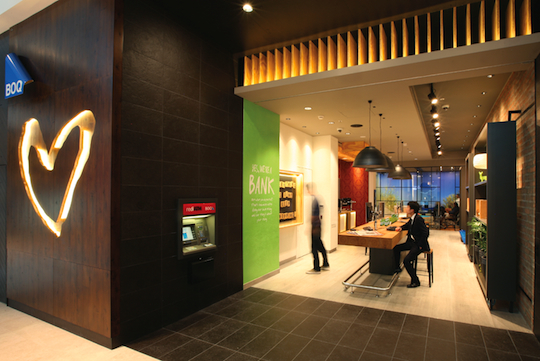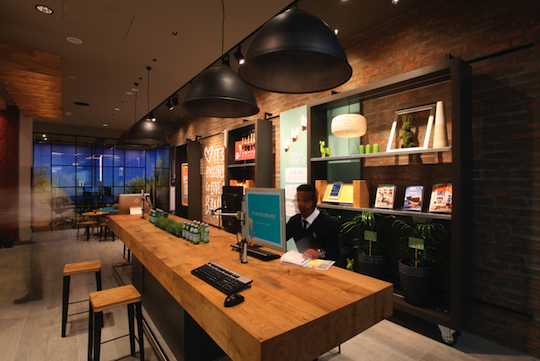Bank of Queensland is radically redesigning the branch experience
Share
Marketing talks to Bank of Queensland’s Philippa Bartlett about how the bank is taking a radical departure from traditional branch design with a new concept it plans to roll out nationwide.
Aiming to bring to life the concept, “it’s possible to love a bank”, the new open plan branches will focus on facilitating conversations and customer relations rather than transactions. The new branches will be centred around a large table with cafe-style features to facilitate side-by-side discussion with staff, as well as offering the convenience of self-service devices.
BOQ says its four-branch trial by Public Design Group is delivering twice the results of existing branches, and the concept won the retail category at the Sydney Design Awards last year.
The bank plans to roll out the concept in multiple locations throughout the country, assessing each branch on its merit when leases expire, then considering refurbishment or relocation.
Marketing chatted to Philippa Bartlett, general manager of corporate network and retail transformation, about the project.
Marketing: Could you tell me a bit about what the redesign of the branches is all about and how it’s been going?
Philippa Bartlett: Two years ago now we relaunched our brand ‘It’s Possible to Love a Bank’. That was really born from understanding why customers chose to bank with BOQ and for us that really comes down to that relationship model. Strong relationships with, in particular, customers and branch staff members. What we realised pretty early on was that our branch design and configuration didn’t really match our customer proposition of real partnership and relationship. For us it was really important that we designed a physical presence that was aligned to customers loving a bank. For us that was about authenticity within the physical environment. The customer being in charge and true partnership, side-by-side with our customer when we have our conversations.
M: What were some of the issues going on that sparked the idea to go in this direction?
PB: One thing we know is that the bank branch is no longer about the telling counter. We know that customers are increasingly using their laptop at home, their iPad, the phone in their pocket to do low or simple transactions. We know that the need for a face-to-face interactional conversation within a branch for more complex type discussion, more complex transactions, that hasn’t changed for 50 years. The need for our branch is to become far more focused on complex conversations, high level of capability of our staff and less about the simple transaction that people are doing on their phone in their pockets or on the train on the way to work, was really behind the fundamental design of the branch moving forward.
M: Everybody at the moment is talking about how banks need to innovate and have really awesome apps and have great online opportunities for customers. Do you feel like that hasn’t changed the need for customers to come in and speak to humans every now and then? Is that kind of getting lost in that conversation about digital?
PB: Customers want to be able to do the basic transaction when they want to do it, where they want to do it. So the need for apps and online banking remains fundamental for a customer. The need or necessity for a customer to want to have a face-to-face conversation at those emotional times when they’ve identified a house that they want their family to move into, or the perfect car they want to be able to purchase; the need for a face-to-face conversation to really explain those processes and explain the type of products – that fundamentally remains unchanged.
M: What can you tell me a bit about the design itself and why you decided to go in that direction? For example, I know it’s quite open plan and there’s some pretty funky decor.
PB: What was important for us was that the customer was in charge of any interaction within the branch. The customer can choose if they want to use the self-service through the ATM, through the iPad or through the iPhones then it’s absolutely up to them to do so. However, if they would like to transact talking to a real life person, equally we’re going to set up the environment for them to do that.
We removed all barriers and every interaction that we have with our customers is actually side-by-side. We call it a ‘partnership’. Whether that be having a conversation with a customer at the central bench about their finances, in an office, again side-by-side, as we talk about the more complex of their needs or even at the telling bench, again that transaction would be side-by-side.
One, it’s about a customer being in charge and two, it’s about a real partnership. That’s really important as it plays out in the physical environment as well for us.
M: It sounds quite different to what anybody else is doing out there in the market. Are you pioneers in this space?
PB: From a banking point of view, yes. This isn’t about us doing something which is different to our competitors. This is us really building a physical environment which suits our brand and suits exactly what customers are asking from us.
M: You’ve had quite a lot of success – the branch has delivered twice the results of the old ones, and on the Sydney Design Awards website it says that in the first week of trading the branch outperformed your number one flagship store on Queen St in Brisbane. How do you measure that and determine the success there?
PB: There are various ways. One is the sales made from the branch but it just as important as the customer feedback and the anecdotal feedback that we get via compliments into the branch and feedback we source from customers directly. The branch design for us is about what our customers are asking for and we will continue to tweak and amend the design and make sure we get it spot on as we roll out the pilot.
M: Were there any issues at all, or any discomfort in customers talking in that open plan environment? That side-by-side set up is quite different. Did it go well?
PB: The feedback has been overwhelmingly positive and in every branch we have a minimum of two fully secure and private office spaces to have the more complex conversation. Again, as the customer is in charge the customer can choose and communicate with us as to the best space within that environment to have the type of conversation that they would like to have with us.
M: In terms of instilling trust and professionalism, do you worry about the message that the redesign is sending to customers and the finance industry, or are you quite confident in still being able to still be a bank that’s trusted?
PB: The beauty for us is that we have existing customers within the geography of every one of our new pilot branches that we’ve opened. Both the feedback from new customers and existing customers has been overwhelmingly positive. We’re actually very confident and optimistic.
M: You won the retail category at the Sydney Design Awards last year. How pivotal was that in the decision to call the trial a success?
PB: It was nice recognition but for us, the only real measure of success is how customers feel about the environment that was created for them, to be honest with you.
M: Finally, is there a particular type of target customer that you’ve got in mind with all of this?
PB: The environment that we’ve created is both to reflect the current customers that we have and then also reflect the location that we’re going into. We have what we called a ‘community space’ in every branch which really pulls the best of the community, the best of the community’s sponsorships, things relevant to the community into that area. So really what we’re trying to do is design an environment that any person in that community would feel comfortable coming in and having a conversation with us in.
All images courtesy Public Design Group.

















